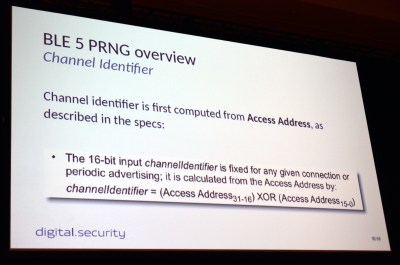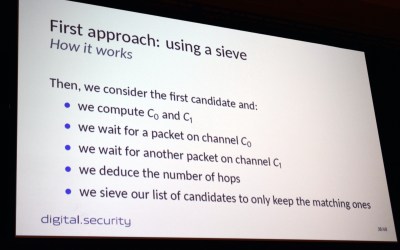Bluetooth Low Energy (BLE) 5 has been around since 2016 with the most recent version 5.2 published just this year. There’s not much hardware out there that’s using the new hotness. That didn’t stop [Damien Cauquil] from picking apart BLE 5’s new frequency hopping techniques and updating his BtleJack tool to allow sniffing, jamming and hijacking hardware using the new protocol.
As you can imagine, the BLE standard a complicated beast and just one part of it is the topic here: the PRNG-based frequency hopping scheme that is vastly different from BLE 4.x and earlier. The new standard, called Channel Selection Algorithm (CSA) #2 — uses 65535 possible channels, compared to just 37 channels used by its predecessor. Paired devices agree to follow a randomized list of all possible channels in sequence so that they remain in synchronization between hops. This was put in place to help avoid collisions, making it possible for many more BLE devices to operate in close proximity. This is important to note since it quickly becomes obvious that it’s not a robust security measure by any means.
 To begin channel hopping the two devices must first agree on an order in which to hop, ensuring they’ll meet one another after each leap. To do so they both run the same 32-bit seed number through a PRNG algorithm, generating a list that will then be followed exactly in order. But it turns out this is not very difficult to figure out. All that’s needed is the access address whose top 16-bits are publicly available if you’re already sniffing packets, and the bottom 16-bits is the counter that increments the hop address list.
To begin channel hopping the two devices must first agree on an order in which to hop, ensuring they’ll meet one another after each leap. To do so they both run the same 32-bit seed number through a PRNG algorithm, generating a list that will then be followed exactly in order. But it turns out this is not very difficult to figure out. All that’s needed is the access address whose top 16-bits are publicly available if you’re already sniffing packets, and the bottom 16-bits is the counter that increments the hop address list.
If you want to jam or hijack BLE 5 communication you need to establish which “randomized” channel list is being used, and the value of the counter that serves as an index to this list. To do so, [Damien] sniffs packets on two different channels. These channels will be used over and over again as it loops through the channel list, so calculating how much time occurs between each channel indicates how far apart these channels are on the list.
 In practice, [Damien] first implemented a sieve (the same concept as the Sieve of Eratosthenes for finding primes) that starts with a list of all possibilities and removes those that don’t contain a matching timing between the two channels. Keep doing this, and eventually, you’ll whittle your list down to one possible channel order.
In practice, [Damien] first implemented a sieve (the same concept as the Sieve of Eratosthenes for finding primes) that starts with a list of all possibilities and removes those that don’t contain a matching timing between the two channels. Keep doing this, and eventually, you’ll whittle your list down to one possible channel order.
This certainly worked, but there were timing issues that sometimes meant you could learn the seed but couldn’t then sync with it after the fact. His second approach uses pattern matching. By measuring hops on 11 consecutive channels, he’s able to synchronize with target devices in a minute or less. From there, jamming or hijacking methods come into play. The randomization of this scheme is really marginal. A more robust technique would have used an internal state in both devices to generate the next hopping channel. This would have been much more difficult for an attacker to figure out. From the device perspective, CSA #2 takes very little computation power which is key for power-sipping IoT devices most often using BLE.
As mentioned before, [Damien] had trouble finding any hardware in the wild using the BLE 5 standard. His proof of concept is built on a pair of nRF52840 development boards. Because it needs more testing, the code hasn’t been merged into the main version of BtleJack, but you can still get it right now by heading over to BtleJack repo on GitHub.
















So it’s using a one time pad while leaving it possible to figure out which one of a fixed number of OTP possibilities both ends of the connection decide to use.
Far more secure would be to make a connection on one channel then have the first data after connection be what random channel and random time the next hop will be, and same for each new channel hop. In other words a new single entry OTP with each channel hop. That shouldn’t take any more power. The new hop info just goes out in the first data packet.
This isn’t using a one time pad as the important property is to never be reused, with n tables there would never be more than n connections.
Actual security in a widely deployed system for information exchange, will never happen. There are too many TLA and ETLA agencies involved in the standards bodies. https is broken by design (all top level certificate authorities can issue certificates that valid for any domain to allow easy man-in-the-middle, that does not happen by accident). GSM ? https://en.wikipedia.org/wiki/A5/1#Security 56-bits by design.
Pretty much every mass communication or data transfer system has some intentional legal intercept points because of legal requirements or the designs bodies stop at “good enough” security. The only except I can think of would have been skype(originally implemented by a EU company based in Luxembourg, not a member of the five eyes and most communications were point to point) before Microsoft (US company) bought and redesigned it to route all data through Microsoft owned supernodes, to add a tap for unencrypted access.
Sorry GSM was 54-bit (not 56-bit) – the Germans wanted stronger and the British wanted weaker.
But is anyone pretending that the channel-hopping is for security?
Yep, every corner-cutting manager absolutely would and marketing would run with it.
You don’t know much about Bluetooth Low Energy, do you?
The standard includes very extensive crypto for all communication happening between the devices, even going as far as permitting to protect the identity of the devices while still allowing persistent bonding (“pairing” in the old Bluetooth Classic). All communication is encrypted.
Channel hopping is certainly not a security feature by any measure.
I also wonder why this is even an issue. Channel hopping is not a security feature.
In order to hijack communication of a BTLE device that actually cares about security you need to guess/break the session keys that are established by the pairing process at each connection (the device “pairing” we knew from Bluetooth Classic is called “bonding” in BTLE parlance and it is a different thing).
Knowing the radio channel where the devices are talking to each other is only the start and permits to jam the communication at best unless you have more information.
it depends what kind of security you meaning…
if you about channels jamming then YES, it’s about security.
If you about data protection or hiding fact of data transfer then answer NO.